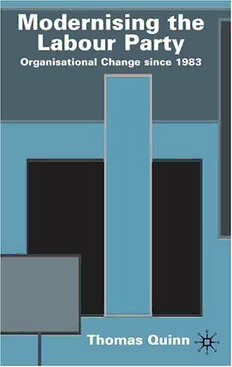
Modernising the Labour Party: Organizational Change since 1983 PDF
248 Pages·2005·0.803 MB·English
Most books are stored in the elastic cloud where traffic is expensive. For this reason, we have a limit on daily download.
Preview Modernising the Labour Party: Organizational Change since 1983
Description:
Few parties have undergone such comprehensive organizational change as the Labour Party since 1983. Labour's organization once institutionalized the political exchange between office-seeking politicians and the party's policy-seeking trade union paymasters. Using accessible rational choice models, Thomas Quinn explores how consecutive election defeats prompted party leaders to modernize this structure to regain voters' trust, reducing union influence in policymaking, parliamentary candidate selection and leadership contests. The price may be a centralized party vulnerable to membership exit and union funding cuts.
See more
The list of books you might like
Most books are stored in the elastic cloud where traffic is expensive. For this reason, we have a limit on daily download.
